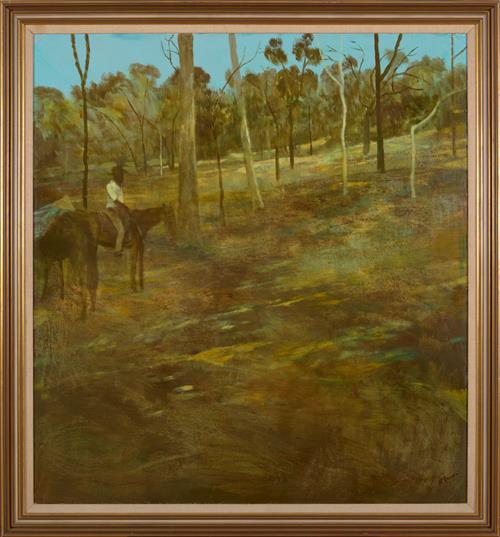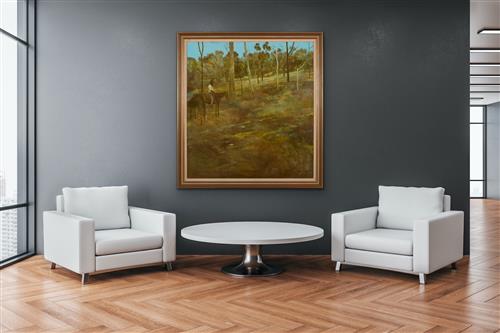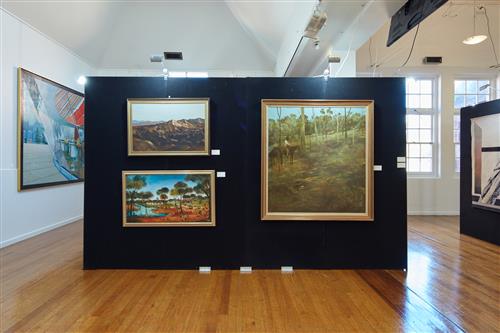Lot 38
Boundary Rider, Palmer River Country, North Queensland c.1970
oil on canvas laid on board
signed lower right: R Crooke
titled on gallery label verso
131 x 121cm
Estimate $30,000 - $50,000
Please contact us directly for a condition report on this lot.
The opinions expressed in the condition reports are a guide only and should not be treated as a statement of fact. Prospective buyers are encouraged to physically inspect item, or book a virtual viewing or request further images during our pre-sale period where Leonard Joel staff are available for advice.
Please note condition reports can be amended during the pre-sale period, so we strongly suggest any interested bidders check the published condition report available on the website before the auction commences. Leonard Joel makes no guarantee of the originality of mechanical or applied components. Absence of reference to such modifications does not imply that a lot is free from modifications.
Artarmon Galleries, Sydney (label verso)
The National Australia Bank Art Collection (label verso)
The Seventies: Australian Paintings and Tapestries from the Collection of National Australia Bank, National Gallery of Victoria, Melbourne, 15 October - 28 November 1982
Lindsay, R. (ed.), The Seventies: Australian Paintings and Tapestries From the Collection of National Australia Bank, The National Bank of Australasia, Melbourne, 1982, pl. 27, p. 40 (illus.)
Ray Crooke travelled from his Yorkey's Knob base (near Cairns) to be part of an expedition (with artists Percy Trezise and Dick Roughsey, and an optometrist named Frank Woolston) sponsored by the Cooktown Historical Society in 1969. They retraced a track across the Great Dividing Range that led to the site of the Palmer River gold-fields which, for a brief time in the late 1800s, had brought people from all over the world to this remote place in Queensland. Rosemary Dobson writes, "He saw man's brief occupation of the landscape, not in terms of myth and drama, but as a transient incident now only perceptible in superficial traces"(1).
Crooke had first experienced northern Australia and the Cape York peninsula as a soldier in 1942 during a journey from Western Australia to Queensland. His engagement with the essential qualities of this place subsequently drove many of his paintings of the Australian landscape. These essays on light and heat, vegetation and country have largely been overshadowed in the public view by his other colourful and lyrical depictions of the Torres Strait and Pacific Islands and their peoples. However, the landscapes and paintings such as Boundary Rider offer a powerfully different contribution, vignettes that evoke a sensory awareness of the temperature and tenor of these places, often featuring a solitary figure who waits. As curator Sue Smith writes, paintings from the Palmer River "convey a deep sense of the sometimes tenuous presence, and historic resonance, of Australians in the dry, inhospitable and vast expanses of the continent"(2).
In Boundary Rider, Crooke's personal reticence is visible in the shadowed features of the Aboriginal rider, whose horse almost disappears into the shimmering heat of the landscape. The light on this grassy, forested hill is searing, and its dryness is reflected in the Giotto-influenced translucence of the paint, which evokes the intensity of the northern Australian environment. Writer George Johnston (the subject of Crooke's Archibald Prize-winning portrait in 1970) wrote a foreword to the Palmer River paintings exhibition held at the Johnstone Gallery in 1970 (10 July to 1 August). He suggests, "… [Crooke] has painted this [country] not representationally, nor even mythically, but I think metaphysically… He is concerned with a glimpsed, muted, immobile, strangely haunted landscape, where the flow of time past, and time present, and time eternal is an almost visible, portrayable thing"(3).
Crooke was also aware of and sympathetic to the plight of Aboriginal people, and sensitive to his own contextual "ill-digested background of European culture"(4). His paintings become a response to "rightness of the Aborigine" in his own country (5). He suggested that, "His poetry, song, and dance is the country, yet it is not mine."(6) In this painting he places the Aboriginal stockman in Country, with a strong sense of the ongoing emotional resonance between this (and all) man and nature. Its narrative is elusive, working slowly on its viewer to conjure the atmospherics and environment of this place and its people, an uneasy but intriguing landscape into which we may project. The position of the rider on the far left hand side of the canvas and on the downward slope of the hill speaks to both its title and the status of Aboriginal people, so often driven to the edge.
Crooke wrote to Smith (in 1992) that his interests in the European masters such as Giorgione "allowed me to appreciate the Australian landscape - especially in the Laura and Palmer River paintings where I was able to introduce the stockman and pack horses in place of gods and shepherds"(7). The tonal register of browns, greens and yellows undulating across the land and trees possess and contain the stockman, with the intensity of the blue sky a counterbalance to the darkness of the foreground.
Louise Martin-Chew
(1) Dobson, R., Focus on Ray Crooke, UQP, Brisbane, 1971, p. 40
(2) Smith, S., North of Capricorn: the art of Ray Crooke, Perc Tucker Regional Gallery, Townsville, 1997, p.15
(3) Quoted in Dobson,R., Focus on Ray Crooke, UQP, Brisbane, 1971, p.45
(4) Ibid p. 17
(5) Ibid p. 16
(6) Ibid p. 17
Important Works from the NAB Art Collection
AUCTION
Sale: LJ8563
6:00pm - 23 February 2022
333 Malvern Rd, South Yarra 3141
VIEWING
Friday 18 February, 10am - 7pm
Saturday 19 - Sunday 20 February, 10am - 4pm
Monday 21 - Tuesday 22 February, by appointment
333 Malvern Road, South Yarra VIC
CONTACT
Summer Masters
nab.art@leonardjoel.com.au
SIMILAR ITEMS
Lot 66
HAROLD SEPTIMUS POWER (1878-1951) The Bullock Team c.1914 oil on canvas laid on board
Estimate: $70,000-90,000
Lot 86
WILLIAM DELAFIELD COOK (1936-2015) A Hedge 1974 synthetic polymer paint on canvas
Estimate: $40,000-60,000
Lot 25
MIRKA MORA (1928-2018) Curlews in the Garden 1980 wool, cotton and lurex tapestry
Estimate: $35,000-45,000
Lot 46
HUGH SAWREY (1923-1999) A Confidential Moment in the Bar of the Cattle Camp Hotel, Charleville, Queensland oil on board
Estimate: $35,000-45,000



